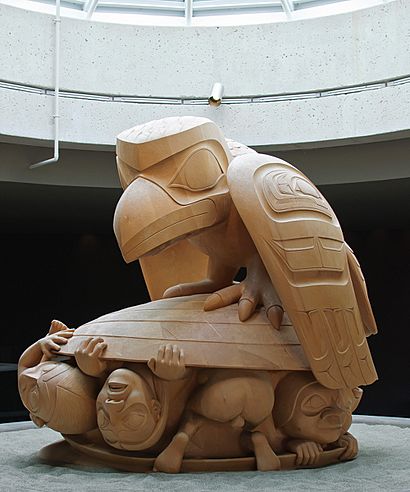The Raven and the First Men facts for kids
Quick facts for kids The Raven and the First Men |
|
|---|---|
 |
|
| Artist | Bill Reid |
| Year | 1978 |
| Type | Laminated yellow cedar |
| Dimensions | 1.88 m × 1.92 m (6 ft 2 in × 6 ft 4 in) |
| Location | UBC Museum of Anthropology, Vancouver |
| 49°16′10″N 123°15′35″W / 49.269366°N 123.259596°W | |
The Raven and the First Men is a famous sculpture by a talented artist named Bill Reid. He was from the Haida nation. This amazing artwork tells an important story from the Haida culture. It shows how the first people came into the world. The sculpture is made from a special type of wood called yellow cedar. Bill Reid started carving it in 1978, and it took him two whole years to finish! You might have even seen this sculpture before. It used to be on the back of the Canadian twenty-dollar bill.
The Haida Creation Story
The sculpture Raven and the First Men shows a very old story from the Haida culture. This story is about how the world and the first humans were created. It features a clever and curious character called the Raven.
According to the myth, the Raven landed on a beach called Rose Spit Beach on Haida Gwaii. He heard some strange noises coming from a giant clamshell. Inside the shell, there were tiny creatures. They were too scared to come out.
The Raven was very curious. He used his beak to gently encourage them. The little beings were also curious about the world outside. Slowly, they came out of the clamshell. These creatures became the very first Haida people!
At first, the Raven noticed that all the beings who came out were men. He watched them explore and play, but he soon got a little bored. He decided to find women for them. The Raven found a type of sea creature called a chiton. He opened one up and discovered tiny women living inside!
He brought the women to the men. The Raven loved watching them interact and behave. Soon, the men and women started families and moved to different parts of the island. The Raven was never bored again, watching the humans and their families grow.
How the Sculpture Was Made
Bill Reid started working on this big sculpture after making a tiny version first. This small carving was made from boxwood in 1970. It was inspired by another Haida artist named Charles Edenshaw. The small artwork was called The Raven Discovering Mankind in a Clamshell.
A businessman named Walter Koerner saw the miniature sculpture. He loved it so much that he asked Bill Reid to make a much bigger one in 1973. This larger sculpture was meant for the Museum of Anthropology. There is also another small version of the sculpture made from onyx. Both of these smaller carvings are kept at the Bill Reid Gallery of Northwest Coast Art. A tiny gold version was even sold for over $100,000 in 2005!
Making the big sculpture was a challenge. It was hard to find a single, perfect block of red cedar wood. Many large blocks had problems like rot or other flaws. Luckily, a company called Rayonier Canada donated several large beams of yellow cedar. These beams were glued together with help from Koppers International. This became the special wood used for the sculpture.
The actual carving began in the fall of 1978. The first rough shaping of the wood was done with help from Gidansda Guujaaw and George A. Norris. The detailed carving of the men inside the clamshell was done by George Rammell. The final touches and smoothing were completed by Reg Davidson and Jim Hart.
Gallery




